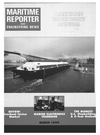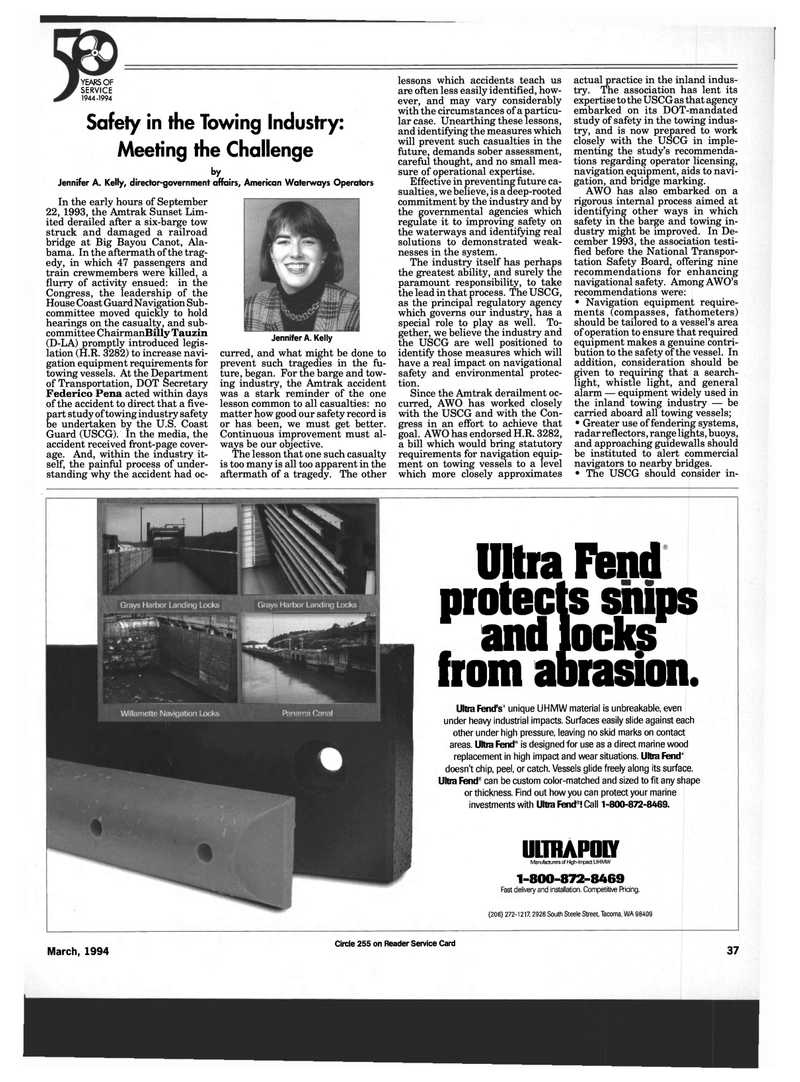
Page 35: of Maritime Reporter Magazine (March 1994)
Read this page in Pdf, Flash or Html5 edition of March 1994 Maritime Reporter Magazine
actual practice in the inland indus- try. The association has lent its expertise to the USCG as that agency embarked on its DOT-mandated study of safety in the towing indus- try, and is now prepared to work closely with the USCG in imple- menting the study's recommenda- tions regarding operator licensing, navigation equipment, aids to navi- gation, and bridge marking.
AWO has also embarked on a rigorous internal process aimed at identifying other ways in which safety in the barge and towing in- dustry might be improved. In De- cember 1993, the association testi- fied before the National Transpor- tation Safety Board, offering nine recommendations for enhancing navigational safety. Among AWO's recommendations were: • Navigation equipment require- ments (compasses, fathometers) should be tailored to a vessel's area of operation to ensure that required equipment makes a genuine contri- bution to the safety of the vessel. In addition, consideration should be given to requiring that a search- light, whistle light, and general alarm — equipment widely used in the inland towing industry — be carried aboard all towing vessels; • Greater use of fendering systems, radar reflectors, range lights, buoys, and approaching guidewalls should be instituted to alert commercial navigators to nearby bridges. • The USCG should consider in-
Ultra Fernl protects snips . and lock? from abrasion.
Ultra Fend's" unique UHMW material is unbreakable, even under heavy industrial impacts. Surfaces easily slide against each other under high pressure, leaving no skid marks on contact areas. Ultra Fend™ is designed for use as a direct marine wood replacement in high impact and wear situations. Ultra Fend" doesn't chip, peel, or catch. Vessels glide freely along its surface.
Ultra Fend® can be custom color-matched and sized to fit any shape or thickness. Find out how you can protect your marine investments with Ultra Fend®! Call 1-800-872-8469.
UHB POW
Manufacturers of High-Impact UHMW lessons which accidents teach us are often less easily identified, how- ever, and may vary considerably with the circumstances of a particu- lar case. Unearthing these lessons, and identifying the measures which will prevent such casualties in the future, demands sober assessment, careful thought, and no small mea- sure of operational expertise.
Effective in preventing future ca- sualties, we believe, is a deep-rooted commitment by the industry and by the governmental agencies which regulate it to improving safety on the waterways and identifying real solutions to demonstrated weak- nesses in the system.
The industry itself has perhaps the greatest ability, and surely the paramount responsibility, to take the lead in that process. The USCG, as the principal regulatory agency which governs our industry, has a special role to play as well. To- gether, we believe the industry and the USCG are well positioned to identify those measures which will have a real impact on navigational safety and environmental protec- tion.
Since the Amtrak derailment oc- curred, AWO has worked closely with the USCG and with the Con- gress in an effort to achieve that goal. AWO has endorsed H.R. 3282, a bill which would bring statutory requirements for navigation equip- ment on towing vessels to a level which more closely approximates 1-800-872-8469
Fast delivery and installation. Competitive Pricing. (206) 272-1217, 2926 South Steele Street, Tacoma, WA 98409
YEARS OF
SERVICE 1944-1994
Safety in the Towing Industry:
Meeting the Challenge by
Jennifer A. Kelly, director-government affairs, American Waterways Operators
In the early hours of September 22, 1993, the Amtrak Sunset Lim- ited derailed after a six-barge tow struck and damaged a railroad bridge at Big Bayou Canot, Ala- bama. In the aftermath of the trag- edy, in which 47 passengers and train crewmembers were killed, a flurry of activity ensued: in the
Congress, the leadership of the
House Coast Guard Navigation Sub- committee moved quickly to hold hearings on the casualty, and sub- committee ChairmanBilly Tauzin (D-LA) promptly introduced legis- lation (H.R. 3282) to increase navi- gation equipment requirements for towing vessels. At the Department of Transportation, DOT Secretary
Federico Pena acted within days of the accident to direct that a five- part study of towing industry safety be undertaken by the U.S. Coast
Guard (USCG). In the media, the accident received front-page cover- age. And, within the industry it- self, the painful process of under- standing why the accident had oc-
Jennifer A. Kelly curred, and what might be done to prevent such tragedies in the fu- ture, began. For the barge and tow- ing industry, the Amtrak accident was a stark reminder of the one lesson common to all casualties: no matter how good our safety record is or has been, we must get better.
Continuous improvement must al- ways be our objective.
The lesson that one such casualty is too many is all too apparent in the aftermath of a tragedy. The other
Circle 255 on Reader Service Card March, 1994 37

 34
34

 36
36
